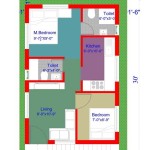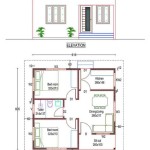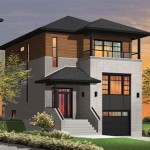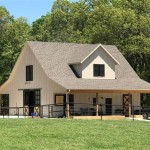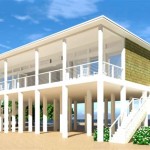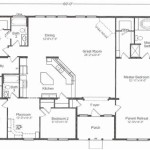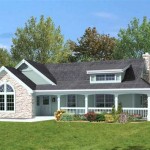L-Shaped House Design Plans: Functionality and Aesthetics Combined
L-shaped house design plans are characterized by two wings that meet at a right angle, forming the shape of the letter "L." This configuration offers a diverse range of architectural possibilities, catering to various lot sizes, orientations, and lifestyle preferences. The inherent design creates distinct zones within the structure, promoting both privacy and social interaction. This article will explore the advantages, considerations, and common implementations of L-shaped house design plans.
The popularity of L-shaped designs stems from their adaptability and efficient use of space. They can be implemented on both large and small properties, offering opportunities for maximizing natural light, creating sheltered outdoor areas, and defining clear boundaries between public and private zones within the home. Furthermore, the design lends itself to various architectural styles, from traditional to contemporary, enhancing its appeal to a broad spectrum of prospective homeowners.
Advantages of L-Shaped House Designs
L-shaped house designs offer several benefits compared to more conventional rectangular or square layouts. These advantages relate to functionality, aesthetics, and efficient utilization of the property.
One primary advantage is the creation of a well-defined outdoor space, such as a patio, courtyard, or garden, within the "L" shape. This enclosed area offers privacy and protection from the elements, creating an ideal setting for outdoor activities, relaxation, or entertaining. The adjacency of the interior spaces to this outdoor area facilitates seamless indoor-outdoor living, promoting a connection with nature and enhancing the overall living experience.
The configuration of an L-shaped house naturally segregates spaces, allowing for a clear distinction between living areas, bedrooms, and service zones. This separation enhances privacy and reduces noise transmission between different parts of the house. For example, one wing might house the bedrooms and bathrooms, while the other wing accommodates the living room, dining area, and kitchen. This zoning strategy is particularly beneficial for families with children or individuals who work from home, as it provides dedicated spaces for different activities.
Another advantage lies in the optimization of natural light and ventilation. The two wings of the house can be oriented to maximize sunlight exposure while minimizing glare and heat gain. Strategic placement of windows and doors allows for cross-ventilation, reducing the reliance on artificial cooling systems and promoting a more comfortable indoor environment. This passive design strategy contributes to energy efficiency and reduces the environmental footprint of the house.
From an aesthetic perspective, L-shaped designs offer a more dynamic and visually appealing appearance compared to simple rectangular structures. The distinct wings and the central courtyard create a sense of depth and complexity, enhancing the architectural character of the house. The design also allows for the incorporation of various architectural features, such as porches, balconies, and gables, further enhancing its visual appeal.
Key Considerations in Planning an L-Shaped House
Designing an L-shaped house requires careful planning and consideration of several factors to ensure optimal functionality and aesthetics. These considerations include site orientation, room placement, structural integrity, and budget constraints.
Site orientation is a critical factor in determining the layout of an L-shaped house. The position of the house on the lot should be carefully considered to maximize sunlight exposure, minimize wind exposure, and optimize views. The orientation should also take into account the prevailing climate and the surrounding landscape. For instance, in warmer climates, orienting the house to minimize direct sunlight exposure during the hottest hours of the day can significantly reduce cooling costs. Similarly, in colder climates, orienting the house to maximize solar gain can help reduce heating costs.
Room placement is another important consideration in designing an L-shaped house. The placement of rooms should be carefully planned to optimize functionality and privacy. Public areas, such as the living room and dining area, should be located in areas with ample natural light and easy access to the outdoor spaces. Private areas, such as the bedrooms and bathrooms, should be located in quieter areas with adequate privacy. The kitchen should be centrally located and easily accessible from both the living and dining areas. The placement of service areas, such as the laundry room and garage, should be carefully considered to minimize noise and disruption to the living areas.
Structural integrity is a paramount concern in any building design, and L-shaped houses are no exception. The connection point between the two wings of the house can be a structural weak point, requiring careful engineering and reinforcement. The foundation must be designed to support the weight of the structure and to resist soil movement. The roof must be designed to withstand wind and snow loads. It is essential to consult with a qualified structural engineer to ensure that the design meets all applicable building codes and safety standards.
Budget constraints are an important consideration in any construction project, and L-shaped houses can be more expensive to build than simpler rectangular structures due to their more complex design. The increased complexity can result in higher material costs, labor costs, and engineering fees. It is essential to establish a realistic budget at the outset of the project and to carefully manage expenses throughout the construction process. Value engineering, a process of identifying cost-saving opportunities without compromising quality or functionality, can be employed to optimize the design and reduce construction costs.
Common Implementations of L-Shaped House Designs
L-shaped house designs are adaptable and can be implemented in various ways to suit different needs and preferences. Common implementations include single-story and two-story designs, courtyard-focused layouts, and designs incorporating garages and accessory dwelling units (ADUs).
Single-story L-shaped house designs are well-suited for smaller lots or for individuals who prefer easy access to all areas of the house without stairs. These designs typically feature a central living area with bedrooms and bathrooms in one wing and the kitchen and dining area in the other wing. The courtyard or outdoor space is often accessible from multiple rooms, creating a seamless connection between indoor and outdoor living. Single-story designs are often preferred by seniors or individuals with mobility limitations, as they eliminate the need for stairs.
Two-story L-shaped house designs offer more living space on a smaller footprint. These designs typically feature the living areas on the ground floor and the bedrooms on the upper floor. The courtyard or outdoor space can be accessed from the living areas on the ground floor, while the upper floor may feature balconies or terraces overlooking the courtyard. Two-story designs are well-suited for families who need more space but have a limited lot size.
Courtyard-focused layouts emphasize the creation of a private and sheltered outdoor space within the "L" shape. These designs often feature large windows and doors that open onto the courtyard, blurring the boundaries between indoor and outdoor living. The courtyard can be used for a variety of purposes, such as a garden, a patio, a swimming pool, or an outdoor kitchen. Courtyard-focused layouts are particularly well-suited for climates with mild weather, where outdoor living is possible year-round.
L-shaped house designs can also incorporate garages and ADUs. The garage can be attached to one wing of the house, providing convenient access to the interior without having to go outside. An ADU, also known as a granny flat or in-law suite, can be incorporated into the design as a separate living space with its own entrance, kitchen, and bathroom. ADUs can be used for a variety of purposes, such as housing elderly parents, accommodating adult children, or generating rental income. The integration of garages and ADUs requires careful planning to ensure that they complement the overall design of the house and do not detract from its aesthetic appeal.
The selection of materials further influences the overall aesthetic and functionality of the L-shaped house. Traditional materials, such as brick, wood, and stone, can be used to create a classic and timeless look. Modern materials, such as concrete, steel, and glass, can be used to create a contemporary and minimalist look. The choice of materials should be guided by the architectural style, the climate, and the budget. Sustainable materials, such as recycled wood, bamboo, and solar panels, can be incorporated into the design to reduce the environmental impact of the house.

L Shaped House Plans Modern 2024

53 Best L Shaped House Plans Ideas

L Shaped House Plan 3 Bedroom Design For Narrow Lots

Why An L Shaped House Plan Makes The Best Home Design Monster Plans Blog

L Shaped House Design Explained Housing News

Modern Contemporary Style House Plan 1447 Laeticia

L Shaped Home Courtyard Villa Resort Style House Plan Room

L Shaped House Plan

L Shaped House Design 3 Bedroom Floor Plan Images Nethouseplansl

Ranch Style House Plan 2 Beds 5 Baths 2507 Sq Ft 888 Floorplans Com

